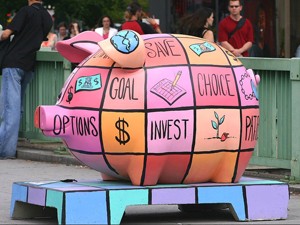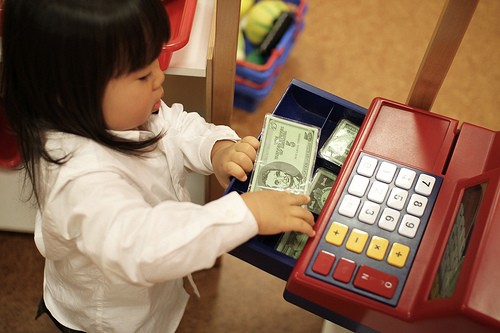Welcome to Money Mondays! April is widely recognized by the financial industry and various consumer protection groups as National Financial Literacy Month, and in honor of it we’ll kick off each week with posts about a variety of hot topics in personal finance as well as resources to help reporters tackle them.
Some financial matters span every age range, while others tend to affect people in specific life stages. We’ll follow that theme and start the month off with some story ideas for finance as it relates to babies, children and teens.
Money is an issue even before birth; the U.S. Department of Agriculture recently published a new Expenditure on Children by Families report and projected that parents will spend an average of $241,080 to raise a child born in 2012. That’s a daunting figure and of course real-life spending varies wildly, but you might parse the averages in various categories (shelter, clothing, school, etc.) and get area budget experts, money-smart bloggers and other pros to offer tips for painlessly paring the tab.
A fun round-up of babysitting rates in various districts and neighborhoods might be a good tsk-tsk feature and a heads-up for teenage entrepreneurs; I’m talking casual parents-night-out or after-school sitting vs. day care and was shocked to hear parents recently saying they’re resigned to $50 in babysitting bills for an evening out. What are the variable rates depending on number and ages of the kids being watched, whether meal preparation or late-night stays are involved, etc? Maybe bartering with prospective sitters might be one way to economizing; trading tutoring or term-paper editing, or cooking or the use of a gadget, in exchange for date-night child care.
Many parents these days know the importance of reading to infants, what how about developing a child’s money sense?
Sometimes frivolous-seeming features can underscore why so many adults grow up to be challenged in financial matters. I once roamed a big chain toy store looking for games and toys that taught kids about money. No dice; a tiny vending machine took money to dispense fake food, dress-up purses held baby cells phones to ingrain personal connectivity but with no mention of the monthly tab, and fashion dolls had glamorous occupations like “shopper” and cruise-ship passenger; none were accountants, financial planners or budget manager. Instructional videos, flash cards and “educational” toys weren’t much better. Though a recent search did turn up a “Trip to the Credit Union” coloring book, which is a start.
Not to sound like the Grinch, but since financial stumbles can affect a person’s choices in education, career, lifestyle and even relationships you might want to talk with educators about what’s lacking in personal finance messages for kids and teens, and try to find some programs in your area that fill the need. The Jump$tart Coalition can put you in touch with member agencies in your state, and here’s an enlightening map of state financial education requirements; you will see that many states have none. Ask legislators and education department officials about the gap.
Tips for making allowances a learning tool, early investing opportunities (yes, kids under age 18 can open a traditional or Roth IRA), gadgets and apps that teach children about money skills, all are components of useful stories that help families fill educational gaps.
The National Credit Union Foundation sponsors Biz Kid$, a TV show that teaches young people about entrepreneurship and basics like credit, spending and the stock market; check with your local credit union about other outreach to teens and children.
Teen earning, spending and saving are interesting topics, especially in recent years when the percentage of employed teenagers has plummeted; according to the latest Bureau of Labor Statistics Employment Situation report, the participation rate in the workforce of those age 16-19 is only about 32 percent. The Las Vegas Sun says youths encountering a bleak jobs market “might be permanently scarred” with reduced earning power following them for a lifetime. What jobs fairs, workshops and other opportunities are out there for teens?
And are they working for pocket money or to contribute to household necessities? What tips do financial planners have for youth; this is a good time to illustrate the wonder of compound interest for those in a position to put by a few dollars. College choices loom too; have a planner outline the lifelong consequences of, say, doing the first two years of undergrad on a pay-as-you-go basis at the local community college vs. the four-year schools teens in your area favor.












